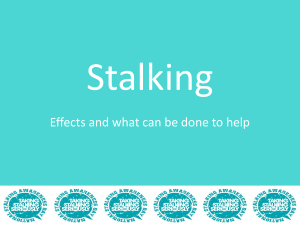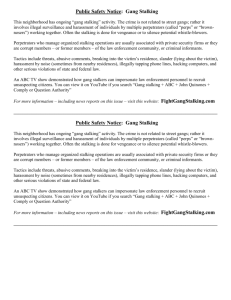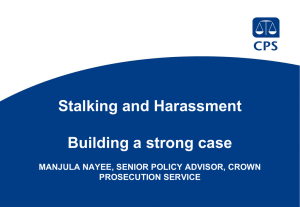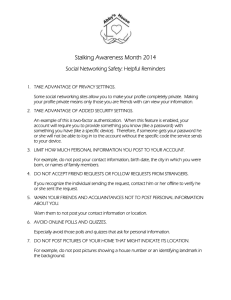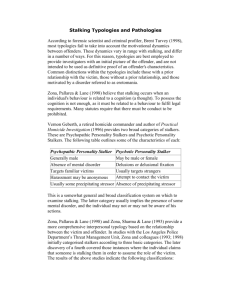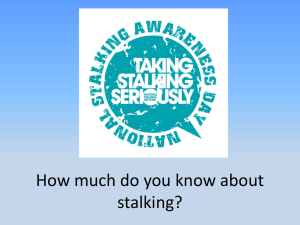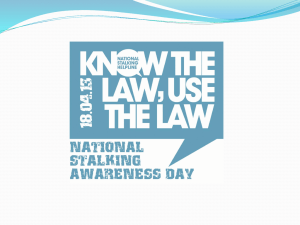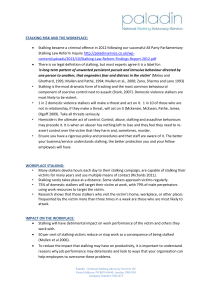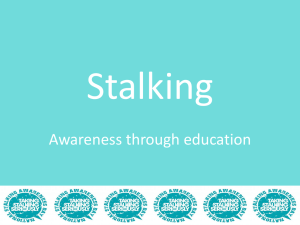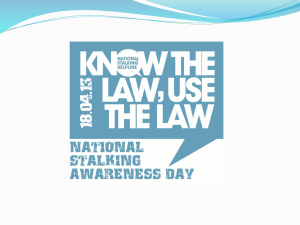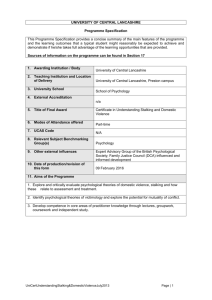jjjjjjjjjjjjjjjjjjjjjjjjjjjjjjjjjjjjjjjjjjjjjjjjjjjjjjjjjjjjjjjjjjjjjjjjjjjjjjjjjjjjjjjjjjjjjjjjjjjjjjjjjjjjjjjjjjjjjjjjjjjjjj
advertisement
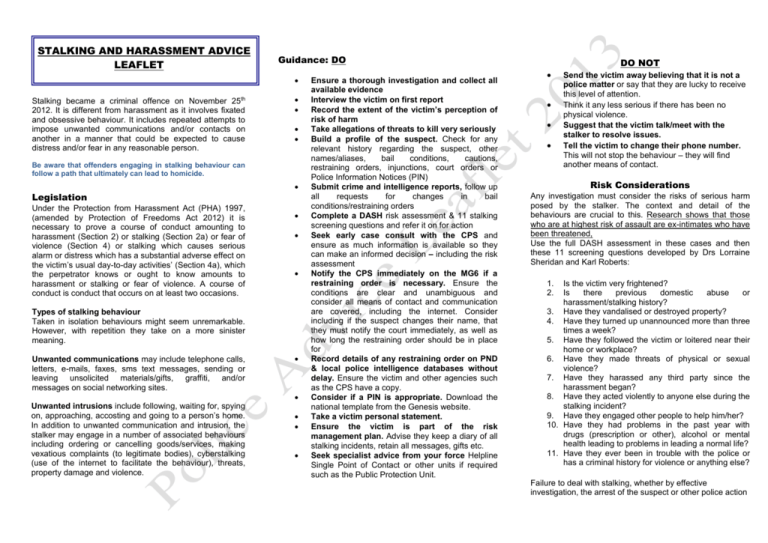
STALKING AND HARASSMENT ADVICE LEAFLET Guidance: DO Stalking became a criminal offence on November 25th 2012. It is different from harassment as it involves fixated and obsessive behaviour. It includes repeated attempts to impose unwanted communications and/or contacts on another in a manner that could be expected to cause distress and/or fear in any reasonable person. Be aware that offenders engaging in stalking behaviour can follow a path that ultimately can lead to homicide. Legislation Under the Protection from Harassment Act (PHA) 1997, (amended by Protection of Freedoms Act 2012) it is necessary to prove a course of conduct amounting to harassment (Section 2) or stalking (Section 2a) or fear of violence (Section 4) or stalking which causes serious alarm or distress which has a substantial adverse effect on the victim’s usual day-to-day activities’ (Section 4a), which the perpetrator knows or ought to know amounts to harassment or stalking or fear of violence. A course of conduct is conduct that occurs on at least two occasions. Types of stalking behaviour Taken in isolation behaviours might seem unremarkable. However, with repetition they take on a more sinister meaning. Unwanted communications may include telephone calls, letters, e-mails, faxes, sms text messages, sending or leaving unsolicited materials/gifts, graffiti, and/or messages on social networking sites. Unwanted intrusions include following, waiting for, spying on, approaching, accosting and going to a person’s home. In addition to unwanted communication and intrusion, the stalker may engage in a number of associated behaviours including ordering or cancelling goods/services, making vexatious complaints (to legitimate bodies), cyberstalking (use of the internet to facilitate the behaviour), threats, property damage and violence. Ensure a thorough investigation and collect all available evidence Interview the victim on first report Record the extent of the victim’s perception of risk of harm Take allegations of threats to kill very seriously Build a profile of the suspect. Check for any relevant history regarding the suspect, other names/aliases, bail conditions, cautions, restraining orders, injunctions, court orders or Police Information Notices (PIN) Submit crime and intelligence reports, follow up all requests for changes in bail conditions/restraining orders Complete a DASH risk assessment & 11 stalking screening questions and refer it on for action Seek early case consult with the CPS and ensure as much information is available so they can make an informed decision – including the risk assessment Notify the CPS immediately on the MG6 if a restraining order is necessary. Ensure the conditions are clear and unambiguous and consider all means of contact and communication are covered, including the internet. Consider including if the suspect changes their name, that they must notify the court immediately, as well as how long the restraining order should be in place for Record details of any restraining order on PND & local police intelligence databases without delay. Ensure the victim and other agencies such as the CPS have a copy. Consider if a PIN is appropriate. Download the national template from the Genesis website. Take a victim personal statement. Ensure the victim is part of the risk management plan. Advise they keep a diary of all stalking incidents, retain all messages, gifts etc. Seek specialist advice from your force Helpline Single Point of Contact or other units if required such as the Public Protection Unit. DO NOT Send the victim away believing that it is not a police matter or say that they are lucky to receive this level of attention. Think it any less serious if there has been no physical violence. Suggest that the victim talk/meet with the stalker to resolve issues. Tell the victim to change their phone number. This will not stop the behaviour – they will find another means of contact. Risk Considerations Any investigation must consider the risks of serious harm posed by the stalker. The context and detail of the behaviours are crucial to this. Research shows that those who are at highest risk of assault are ex-intimates who have been threatened, Use the full DASH assessment in these cases and then these 11 screening questions developed by Drs Lorraine Sheridan and Karl Roberts: 1. 2. Is the victim very frightened? Is there previous domestic abuse or harassment/stalking history? 3. Have they vandalised or destroyed property? 4. Have they turned up unannounced more than three times a week? 5. Have they followed the victim or loitered near their home or workplace? 6. Have they made threats of physical or sexual violence? 7. Have they harassed any third party since the harassment began? 8. Have they acted violently to anyone else during the stalking incident? 9. Have they engaged other people to help him/her? 10. Have they had problems in the past year with drugs (prescription or other), alcohol or mental health leading to problems in leading a normal life? 11. Have they ever been in trouble with the police or has a criminal history for violence or anything else? Failure to deal with stalking, whether by effective investigation, the arrest of the suspect or other police action as appropriate to the circumstance could leave a victim and others at risk. particularly if the victim keeps a log of stalker sightings, all behaviour and preserves any message or ‘gifts’. It may not be possible in the course of an investigation to satisfy all concerns regarding risk. This is particularly relevant where a conviction cannot be obtained. Where an investigation is concluded and concerns exist about the risk of the suspect, they must be considered as a ‘Potentially Dangerous Person’ (PDP) and referred to risk management processes such as MARAC and MAPPA. Research shows that those stalkers who visit the victim’s home, workplace, or other places frequented by the victim more than three times in a week are those who are most likely to attack. What do we know about stalking? In the UK we are only just starting to understand stalking and it’s prevalence. According to the British Crime Survey (2009/10), up to 1 in 20 citizens will experience stalking in the UK in their lifetime, although this is figure is probably just the tip of the iceberg. We also know from research that: Many victims will experience multiple, repeated stalking behaviours before they report this to the police. The majority of stalkers are known to their victims either as ex-partners or acquaintances, but some people are stalked by someone they do not know. Around 80% of stalkers are male. However, stalkers and their victims can be of either gender. Stalkers come from all backgrounds and do not form one ‘type’. Stalkers are not homogenous and the motivation for stalking can vary. Understanding the motivation is important when assessing the risks the stalker may pose. Stalking is life changing. It is frequently injurious to victims’ psychological, physical and social functioning, irrespective of whether they are physically assaulted. Many stalkers will devote hours each day to their stalking campaign, and are capable of stalking their victims for many years. Stalking rarely takes place at a distance. Some stalkers may approach their victims regularly. Others, particularly stalkers with an obvious mental illness, will appear in diverse places at unpredictable times. The positive aspect of this is that evidence can be collected, Stalkers frequently threaten their victims, either directly or indirectly. 1 in 2 of domestic stalkers, when they make a threat, will act on it. Threats have been found to be even stronger predictors in cases of very serious violence, On average victims will suffer 100 incidents before they report it. 21 people connected to the victim will be directly affected by the stalking. Therefore, secondary victims will be identified. Stalkers will involve third parties for a number of reasons including to: upset the victim; obtain information on the victim; remove perceived obstacles between the stalker and victim, and/or to punish those perceived as helping or shielding the victim. The ability of a stalker to pose as other persons and/or to draw information out of third parties should never be underestimated. New technologies and social networking sites can facilitate stalking and harassment, enabling stalkers to impersonate another on-line; to send or post hostile material, misinformation and false messages (i.e. to Usenet groups); and to trick other internet users into harassing or threatening a victim. Substance misuse can also contribute both to the basis from which the stalking occurs and to individual violent episodes. Stalking and mental illness It is clear when people fixate and stalk that they are psychologically unstable, a significant minority are psychotic and some may suffer from undiagnosed personality disorders. Currently stalkers do not routinely get assessed once they come into contact with the criminal justice system. If they do not have access to mental health services they will just continue their behaviour, which is detrimental, costly and dangerous to those that they stalk, as well as to themselves. A significant minority of stalkers have a serious mental illness underlying their stalking behaviour. The longer a stalking episode persists and the more intrusive it is, the greater the likelihood that a mental disorder is contributing to the behaviour. Mental illness is not a defence under the Protection from Harassment Act 1997. Useful Contacts and Organisations Each police service in England and Wales now has a single point of contact (SPOC) for stalking cases. Find out who yours is and contact them if you need further advice. You can also refer to the College of Policing Practice Guidance and to the Crown Prosecution Service Guidance for more detailed information. Police Practice Advice: http://www.npia.police.uk/en/13968.htm CPS Guidance: http://www.cps.gov.uk/legal/s_to_u/stalking_and_harassme nt/ Guidance on digital and cyberstalking: http://www.womensaid.org.uk/page.asp?section=00010001 00280003&sectionTitle=Digital+stalking If you or the victim requires further practical advice contact: Paladin National Stalking Advocacy Service (T): 0207 8408960 (E): info@paladinservice.co.uk (W): www.paladinservice.co.uk (T): @paladinservice National Stalking Helpline (T): 0808 802 0300 (W): www.stalkinghelpline.org (E): advice@stalkinghelpline.org (T): @talkingstalking CIC Number 8361675 Please do not reproduce without permission.
